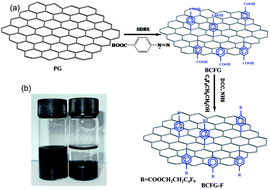In this communication, we report a simple method for a covalent band-forming reaction to change the hybridization of carbon atoms from sp2 to sp3, to introduce a band gap in pristine graphene. Graphene with well-defined functionality was synthesized, and the resulting material was soluble in organic solvent. The LUMO of functionalized graphene was below the LUMO of poly(3-hexylthiophene) (P3HT) and close to that of [6,6]-phenyl C61-butyric acid methyl ester (PCBM), indicating its suitability as an electron acceptor for organic photovoltaic (OPV) applications. We further show the P3HT/functionalized graphene composite as the active layer in a solar cell, with device efficiency of 1.1%.
You have access to this article
 Please wait while we load your content...
Something went wrong. Try again?
Please wait while we load your content...
Something went wrong. Try again?


 Please wait while we load your content...
Please wait while we load your content...